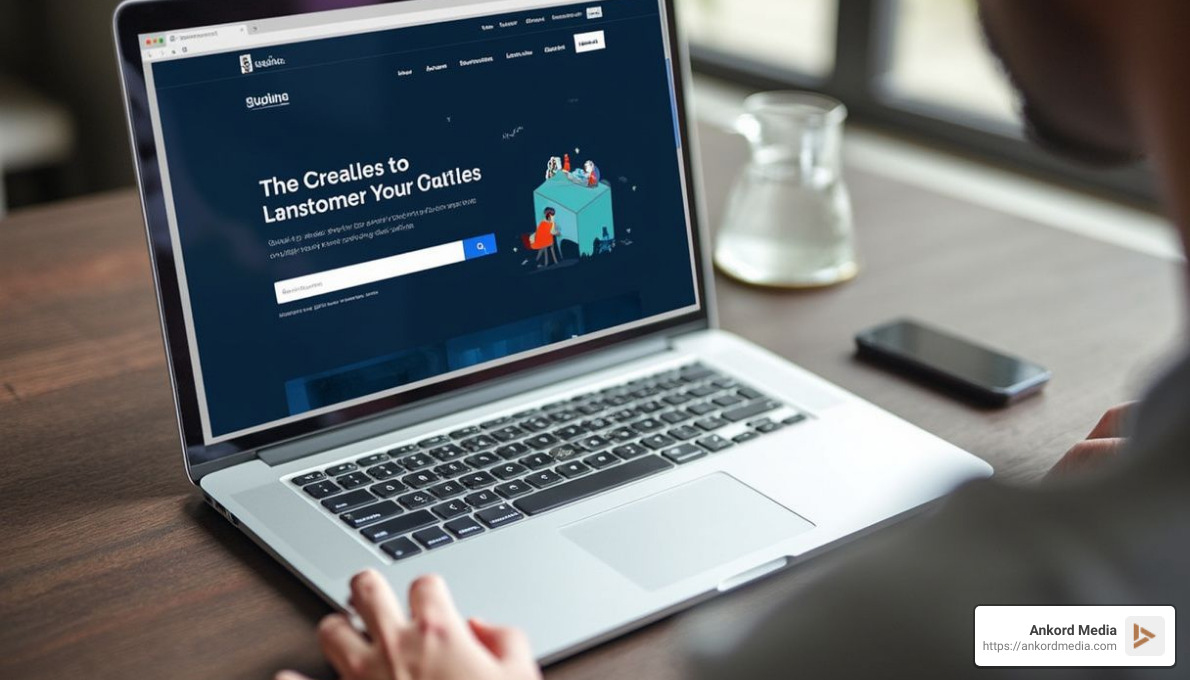From Outdated to Outstanding: Transforming UI and Customer Journeys

Understanding the Need for a Website Redesign
An outdated website design can be more than just an eyesore. It can seriously impact your business by driving users away and diminishing your brand's credibility. 81% of users think less of a brand if its website isn't updated. This statistic alone emphasizes how crucial it is to keep your site fresh and functional.
Outdated Design
Websites that look like they belong in a bygone era can harm your brand image. When users land on a site that seems stuck in the past, they might question the quality of your products or services. An outdated design can also lead to poor navigation and a confusing user experience. Modern design trends, like minimalism and responsive layouts, are not just aesthetic choices but essential components for usability.
User Experience
User experience (UX) is at the heart of any successful website. A cluttered interface, slow loading times, and non-intuitive navigation can frustrate users and cause them to leave your site. Did you know that 88% of people are less likely to return to a website after a negative experience? This statistic underscores the importance of a seamless, user-friendly design. A redesign focused on improving UX can increase user engagement and retention.
Business Goals
Your website should align with your business goals. Whether you aim to increase traffic, generate leads, or boost sales, your site needs to support these objectives. If your current design isn't helping you reach these goals, it's time for a change. A redesign can help you implement new features, improve SEO, and provide a better platform for your marketing strategies.
In conclusion, a website redesign isn't just about aesthetics; it's about creating a user-centered experience that aligns with your business objectives. By addressing outdated design elements and enhancing UX, you can transform your site from a liability into a powerful tool for growth.

Website Redesign to Improve Outdated UI and Customer Journeys
A website redesign to improve outdated UI and customer journeys is a strategic move that can lift your brand, improve user experience, and drive business growth. Let’s explore key areas to focus on:
Navigation
Smooth navigation is the backbone of an effective website. If users struggle to find information, they will likely leave and not return. Simplifying your site's navigation helps users quickly find what they need, increasing engagement and satisfaction.
Consider the case of a legal practice management platform redesigned by product designers. They focused on decluttering navigation, which improved user journeys and conversion rates.

Performance
Performance is crucial for retaining visitors. A one-second delay in page loading can lead to an 11% loss in page views and a 7% drop in conversions. Enhancing performance through a redesign can boost user satisfaction and sales.
For example, optimizing page load speeds and ensuring mobile responsiveness can significantly improve site performance. Did you know that more than half of all organic search engine visits now come from mobile devices? A redesign prioritizing mobile users can capture this growing audience.
Brand Awareness
A website redesign is an opportunity to refresh your brand image. Updating your visual identity can increase brand awareness and attract a broader audience. A modern, cohesive design ensures that your brand is perceived as professional and trustworthy.
Consider a redesign as a chance to introduce a new logo or update your site's color scheme. These changes can make your brand more memorable and appealing to users.

Focusing on navigation, performance, and brand awareness during a website redesign can transform an outdated UI into a powerful tool for enhancing customer journeys. This sets the stage for the next step: understanding how to successfully implement these changes.
Steps to Successfully Redesign Your Website
When starting on a website redesign to improve outdated UI and customer journeys, it's crucial to follow a structured approach. Here's a simple guide to ensure your redesign is a success:
Benchmarking
Start by auditing your current website. Use tools like Google Analytics to gather data on traffic, bounce rates, conversion rates, and load times. This will help you understand what's working and what needs improvement.
Identify high-value pages that generate the most traffic and conversions. These are critical and should be prioritized during the redesign to avoid any performance dips.
Goal Setting
Define clear objectives for your redesign. Align these goals with your business strategy. Are you aiming to increase lead generation, improve user experience, or improve SEO?
Create Key Performance Indicators (KPIs) to measure success. These could include improved conversion rates, higher search engine rankings, or increased mobile traffic.
Audience Analysis
Understanding your audience is key to a successful redesign. Develop user personas based on real data about your current and target customers. This helps tailor the website to meet their needs and expectations.
Map user journeys to identify how users steer your site, from landing on a page to completing a desired action. This insight can guide the redesign to optimize site structure and content for better user flow.
These steps lay a strong foundation for a successful website redesign. Next, we'll dive into the key elements that make a UI redesign effective.
Key Elements of a Successful UI Redesign
When revamping your website's user interface, focusing on a few key elements can transform an outdated design into an outstanding user experience.
Responsive Design
Users access websites from a variety of devices—smartphones, tablets, laptops, and desktops. A responsive design ensures that your website looks and functions well on all screen sizes. This is not just a nice-to-have feature; it's essential. As noted in the research, a significant portion of web traffic comes from mobile devices. If your site isn't mobile-friendly, you risk losing a large chunk of your audience.
Responsive design involves using flexible grids, layouts, and images that automatically adjust to the user's device. This provides a seamless experience, whether someone is browsing on a tiny phone or a large monitor.
Visual Feedback
Visual feedback is a subtle yet powerful way to improve user interaction. It involves providing immediate, visible responses to user actions, like clicking a button or submitting a form. This feedback can be as simple as a button changing color when clicked or a loading spinner appearing while a page is loading.
Effective visual feedback improves user engagement by confirming that their actions have been recognized and are being processed. It reduces uncertainty and frustration, leading to a smoother user experience.
Accessibility
Designing for accessibility ensures that all users, including those with disabilities, can steer and use your website effectively. This is not only a legal requirement in many regions but also a moral obligation to make the web inclusive for everyone.
To improve accessibility, consider using alt text for images, ensuring sufficient color contrast, and enabling keyboard navigation. Tools like screen readers should be able to easily interpret and steer your site. By prioritizing accessibility, you broaden your audience and improve the overall user experience.
With these key elements in mind, your website redesign can significantly improve both the user interface and customer journeys. Next, we'll explore how redesigning can improve customer journeys through improved user onboarding and feature upgrades.
Enhancing Customer Journeys Through Redesign
Redesigning a website is not just about updating its look. It's about changing the entire customer journey to make it smoother and more engaging. Let's dig into how you can achieve this through effective user onboarding, feature upgrades, and a smart content strategy.
User Onboarding
User onboarding is the process of familiarizing new users with your website. A well-designed onboarding experience can make a huge difference. It helps users understand the value of your site quickly and reduces the risk of them leaving out of confusion.
Guided tutorials are a great way to achieve this. They can be optional and offer pop-ups or ToolTips that guide users through new features. This approach ensures users see the benefits of the redesign right away. For instance, Syed from WPBeginner emphasizes the importance of simplifying the customer journey to retain users.
Feature Upgrades
Feature upgrades are essential to keep your website relevant and useful. When launching new products or services, your website should reflect these changes effectively. Think of it like updating the window display of a store to showcase new items.
Consider adding resource centers or special sections that highlight new features. This not only informs users but also engages them with the latest offerings. A redesign is an opportunity to rethink your site's layout to ensure these features are easily accessible.
Content Strategy
A robust content strategy is key to enhancing customer journeys. Content should not only be fresh and engaging but also guide users towards desired actions like making a purchase or signing up for a newsletter.
Simplifying navigation and ensuring that important content stands out can significantly improve conversions. As noted in the research, cluttered navigation and complex user journeys often lead to high bounce rates. By streamlining your content, you make it easier for users to find what they need and take action.
Incorporate visual elements like images and videos to make content more engaging. However, ensure these elements are optimized for performance to avoid slow loading times, which can frustrate users.
By focusing on user onboarding, feature upgrades, and a strategic approach to content, your website redesign can significantly improve the customer journey. Let's move on to address some frequently asked questions about website redesigns and their impact on user engagement and brand awareness.
Frequently Asked Questions about Website Redesign
How does a redesign improve customer journeys?
A website redesign can transform the way users interact with your site, making their journey smoother and more enjoyable. One of the key improvements is navigation. When users can easily find what they're looking for, they are more likely to stay engaged and complete desired actions, like making a purchase or signing up for a newsletter.
For instance, a redesign that focuses on intuitive navigation can lead to higher user engagement. Imagine a website where users can effortlessly glide from product pages to checkout without hitting any roadblocks. This seamless experience not only keeps visitors on your site longer but also encourages them to return.
What are the signs that a website needs a redesign?
There are several telltale signs that it's time for a website redesign. One major indicator is an outdated design. If your site looks like it’s stuck in the past, it can undermine your credibility and make visitors question your relevance. In the digital world, first impressions matter, and an old-fashioned look can drive potential customers away.
Poor performance is another red flag. Slow load times and frequent errors frustrate users. According to research, even a one-second delay in page loading can result in a 7% loss in conversions. If your site struggles to perform, it may be time to rethink its design and optimize for better speed and reliability.
How can a redesign boost brand awareness?
A redesign is a golden opportunity to lift your brand's visual identity and ensure brand consistency across all touchpoints. A fresh, modern design can capture attention and make your brand more memorable. This is especially important in today's crowded digital landscape, where standing out is crucial.
By incorporating cohesive visual elements and a consistent color palette, your brand can leave a lasting impression. This not only improves recognition but also builds trust with your audience. As noted in the research, a well-executed redesign can significantly improve your site's visibility and attract more visitors, ultimately boosting brand awareness.
Next, we'll dig into the essential steps for a successful website redesign, focusing on benchmarking, goal setting, and audience analysis.
Conclusion
In today's digital world, staying relevant is key. At Ankord Media, we specialize in strategic branding and digital change, helping businesses make that leap from outdated to outstanding. Our focus is on crafting digital experiences that resonate with your audience and lift your brand.
A website redesign is more than just a fresh coat of paint; it's about embracing digital change to improve outdated UI and customer journeys. By prioritizing user-friendly design and seamless navigation, we ensure that your website not only looks modern but also functions effectively, enhancing the overall user experience.
Our approach is centered on authentic customer connections and impactful storytelling. We believe that every brand has a unique story, and our job is to tell it in the most compelling way possible. Whether it's through a cohesive color palette or intuitive navigation, we make sure your brand stands out in a crowded digital space.
Partner with us at Ankord Media to transform your bold ideas into success. Together, we can craft a digital presence that not only meets but exceeds your business goals, all while keeping your brand's essence intact. Let's create a website that not only looks great but also delivers exceptional results.
By focusing on strategic branding and embracing digital change, you can turn your outdated website into a powerful tool that engages users and drives business growth. If you're ready to take the next step, reach out to us at Ankord Media.


